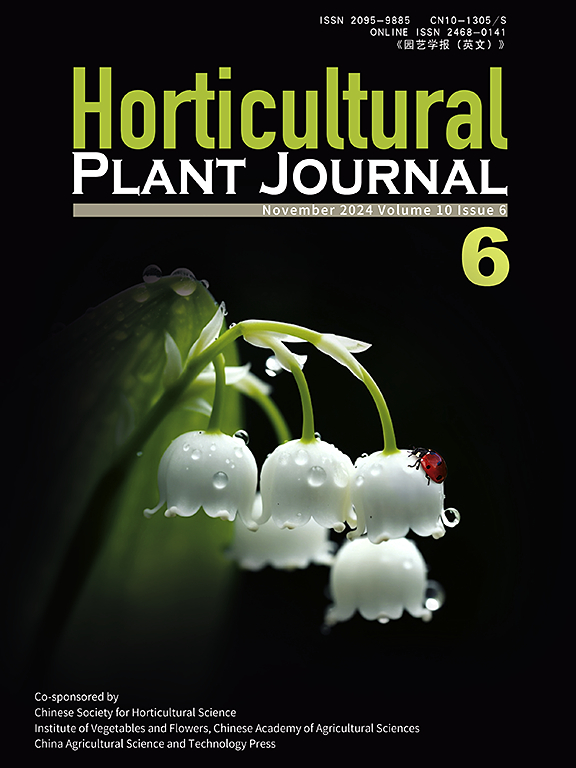GWAS揭示了菊花中4种活性成分的遗传基础和基因组区域
IF 6.2
1区 农林科学
Q1 HORTICULTURE
引用次数: 0
摘要
菊花富含黄酮类化合物和酚酸等活性化合物,其干花通常用于泡茶和药用。然而,菊花活性化合物的遗传决定论仍然难以捉摸。在本研究中,我们连续两年对137份菊花材料的总黄酮、绿原酸、木犀草素和异绿原酸a进行了评估。4种活性化合物变异较大,变异系数在44.96% ~ 76.30%之间。基因型和环境差异显著,广义遗传力在0.5 ~ 0.63之间。四种活性化合物之间存在显著的两两相关。结合隶属函数和层次聚类分析方法,找出了几种活性成分最高的材料,供育种使用。基于327042个高质量snp,全基因组关联研究(GWAS)捕获了4种活性化合物的59个显著snp,其中24个精英等位基因表现出金字塔效应。共挖掘到18个潜在候选基因,其中evm.model.scaffold_1149.273 (QUA1)具有一个与木草素含量最高的Hap4对应的连锁不平衡(LD)区。研究结果有助于了解菊花中活性物质的遗传基础,为菊花中活性物质的遗传改良提供亲本材料和有价值的标记物。本文章由计算机程序翻译,如有差异,请以英文原文为准。
GWAS reveals the genetic basis and genomic regions underlying four active compounds in chrysanthemum
Chrysanthemum is rich in active compounds such as flavonoids and phenolic acids, and its dried head flowers are commonly used for tea and medicinal purposes. However, the genetic determinism underlying chrysanthemum active compounds remains elusive. In this study, we evaluated a panel of 137 chrysanthemum accessions for total flavonoids, chlorogenic acid, luteolin, and isochlorogenic acid A across two consecutive years. The four active compounds exhibited considerable variation, with a coefficient of variation ranging from 44.96 % to 76.30 %. Significant differences were observed in genotype and environments, and the broad-sense heritability was estimated at 0.5–0.63 for all examined traits. Significant pair-wise correlation was found between the four active compounds. Several accessions showing the highest active compounds were figured out for breeding use by integrating the membership function and hierarchical cluster analysis methods. Based on the 327 042 high-quality SNPs, a genome-wide association study (GWAS) captured 59 significant SNPs for the four active compounds, of which 24 elite alleles exhibited pyramiding effects. A total of 18 potential candidate genes were mined, among which evm.model.scaffold_1149.273 (QUA1 ) has one linkage disequilibrium (LD) block corresponding to Hap4 with the highest luteolin content. The findings are beneficial to understanding the genetic basis of the active compounds and provide parental materials and valuable markers for the genetic improvement of active compounds in chrysanthemum.
求助全文
通过发布文献求助,成功后即可免费获取论文全文。
去求助
来源期刊

Horticultural Plant Journal
Environmental Science-Ecology
CiteScore
9.60
自引率
14.00%
发文量
293
审稿时长
33 weeks
期刊介绍:
Horticultural Plant Journal (HPJ) is an OPEN ACCESS international journal. HPJ publishes research related to all horticultural plants, including fruits, vegetables, ornamental plants, tea plants, and medicinal plants, etc. The journal covers all aspects of horticultural crop sciences, including germplasm resources, genetics and breeding, tillage and cultivation, physiology and biochemistry, ecology, genomics, biotechnology, plant protection, postharvest processing, etc. Article types include Original research papers, Reviews, and Short communications.
 求助内容:
求助内容: 应助结果提醒方式:
应助结果提醒方式:


